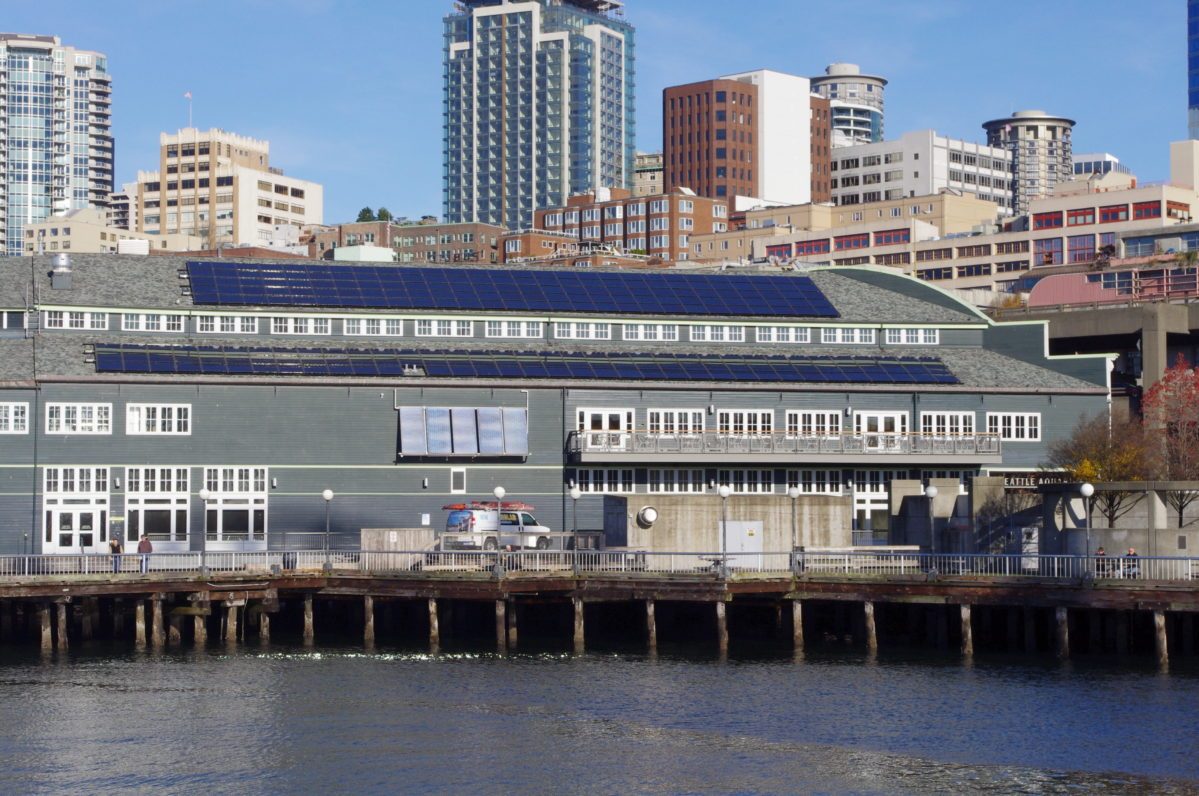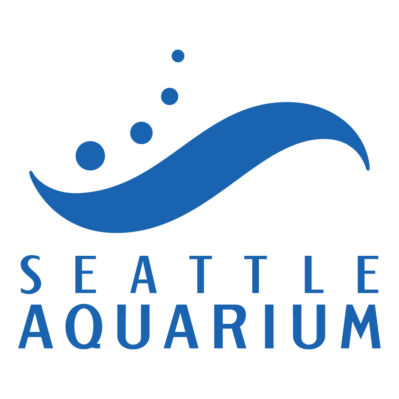Emissions
GOAL: Climate Positive Scope 1, 2, and select scope 3 Greenhouse Gas (GHG) emissions
Goal Update
2024: Net-positive carbon emissions, 695 MtCO2e before offsets
Goal: Climate Positive, 0 MtCO2e Scope 1, 2, and select Scope 3 greenhouse gas emissions by 2030
Note: New data points and scopes are added each year
Note: Animal Care Center (ACC) went online in April 2022 and Ocean Pavillion (OP) went online in 2024
All measurements in metric tons of carbon dioxide equivalent. * = COVID pandemic year
Defining Climate Positive
The Seattle Aquarium defines climate positive as going beyond carbon neutral. To be climate positive is to:
- Prioritize reducing Scope 1, 2 and 3 emissions
- Offset remaining emissions plus additional investments in offsets or other programs that exceed measured Scope 1, 2 and 3 emissions
- Purchase offsets via projects that meaningfully align with the Aquarium’s mission and SALISH values (Sustainable, Awe-inspiring, Learning and improving, Inclusive community, Scientific integrity, Honoring place)
- Undertake environmentally regenerative projects that have climate benefits that go beyond the operational impact of the Aquarium’s facilities and generate regenerative environmental and social impacts
In 2024, the Seattle Aquarium purchased 695 MtCO2e through the Cedar Grove-Maple Valley OWC Composting Project (CAR Project ID CAR866). Download Certificate

The Seattle Aquarium’s 49 Kilowatt rooftop community solar array built in partnership with Seattle City Light in 2013 is a visible example of the Aquarium’s commitment to being climate positive.
Sources of GHG emissions
Where do Seattle Aquarium’s emissions come from and why are they increasing?
The primary sources for the Seattle Aquarium’s GHG emissions are natural gas (29%), employee commuting (25%), and energy consumed from leased space at the Market Square (14%). Scope 1 and 2 GHG emissions, emissions generated directly from operations, are decreasing. The Seattle Aquarium continues to measure more Scope 3 emissions and in doing so is inflating current emissions as compared with previous years in which these emissions remained unmeasured.
The Seattle Aquarium collaborates with an outside partner to conduct an annual greenhouse gas inventory.
In 2024, refrigerants were estimated based on square footage and space type.
Sources of GHG emissions (2024)
Recent Efforts
Committing to an all-electric Ocean Pavilion and Animal Care Center
We want to ensure the entire Aquarium, including the Ocean Pavilion and Animal Care Center, are climate-positive, with the smallest energy and carbon footprint possible. Our team has developed innovative strategies to drive efficiency in the building operations of the Ocean Pavilion, which runs on 100% fossil-fuel-free.* heating and cooling systems and electricity, provided by Seattle City Light’s clean grid, and new heat pump technology is utilized to heat and cool the building—reducing the energy use and carbon footprint typically associated with the mechanical systems, such as boilers, of large facilities.
A semi-closed water system for animal life support utilizes a heat exchanger to keep the water at the right temperature and recirculate and recycle water through an advanced denitrification technology, also drastically reduces our water usage as well as our carbon footprint.
*Our back-up generators are powered by diesel fuel and utilized only in the event of an extended power loss, with carbon offsets purchased to minimize impact.
Decarbonization
In 2024 and early 2025 the Aquarium took large steps in decarbonizing Pier 59 by electrifying the cafe kitchen and decommissioning the boiler at the Pacific Coral Reef (PCR) exhibit. Additionally, an engineering analysis was done in 2024 to chart a pathway to full decarbonization for Piers 59 & 60.
Achieving a carbon positive state
The Seattle Aquarium achieved carbon positive through active steps to reduce emissions in tandem with the purchase of carbon offsets for:
- Scopes 1 and 2 beginning in 2014
- Scopes 1, 2, and Scope 3: leased space in 2019
- Scopes 1, 2, and Scope 3s: leased space, procurement of animal feed, and employee commute in 2020
- Scopes 1, 2, and Scope 3s: leased space, procurement of animal feed, employee commute, and business travel in 2023
Purchasing carbon investments that are third-party verified and align with the Aquarium’s mission and values
The Seattle Aquarium invested in the Rimba Raya Biodiversity Reserve project and Katingan Peatland Restoration and Conservation project for 2023. This investment provides a carbon credit allowing the Seattle Aquarium to offset carbon emissions.
Priority Strategies
Preprogram thermostat with agreed-upon set points in all Aquarium spaces
Setpoints allow the Aquarium to remain efficient in heating and cooling the space. During colder times of the year, lowered setpoints might result in staff wearing more layers than preferred, but these setpoints can lead to significant energy savings.
Educate staff about what actions save energy
With new and changing technology, it is not always clear to staff which activities lead to significant energy savings. Clearly communicating which activities reduce energy use will help staff to be successful.
Invest in solar to help local partners generate clean energy elsewhere 
The Seattle Aquarium should consider investing in renewable energy systems outside of facilities we operate, such as rooftop solar on Market Square or with our Coral Triangle partners to support a climate positive future in other parts of the world..
Convert natural gas to electric in Aquarium-operated buildings 
A sustainable future is a future without fossil fuels. Replacing natural gas systems with those that use electricity will reduce GHG emissions and aligns with the City of Seattle’s intent to step away from natural gas.
Recapture heat from life support and mechanical systems 
The mechanical equipment generates significant heat, which could be redirected to heating other habitats rather than released as a waste product. Capturing and using heat will lower energy used to heat water for tropical habitats.
Plan for and implement community-based social marketing campaigns to drive energy-saving behavior
Community-based social marketing campaigns are a successful method for engaging staff, volunteers and our surrounding community to achieve specific outcomes. Identifying specific activities and crafting specific plans will lead to measurable outcomes and also engage staff.
Solve storage issues to make space for upgrades by decluttering and right-sizing space needs 
Storage issues reduce Aquarium efficiency and are a limiting factor on Piers 59 and 60. Creating and planning for adequate space for equipment is necessary for the success of the Aquarium.
Shift PCR to temperate or non-live space
Seawater from the Pacific Coral Reef (PCR) and Ocean Oddities galleries is heated by natural gas and generates a substantial portion of the Aquarium’s total emissions. Once animals are relocated to the Ocean Pavilion, which heats the water with electricity and results in substantially lower emissions, the galleries could be repurposed to a lower-emission activity.
Develop and track Key Performance Indicators for proactive equipment maintenance
Equipment runs most efficiently and produces lower emissions when it is functioning properly.
Continue to influence the region through policy and advocacy 
Engage in policy advocacy to advance environmentally responsible methods to produce renewable energy.




